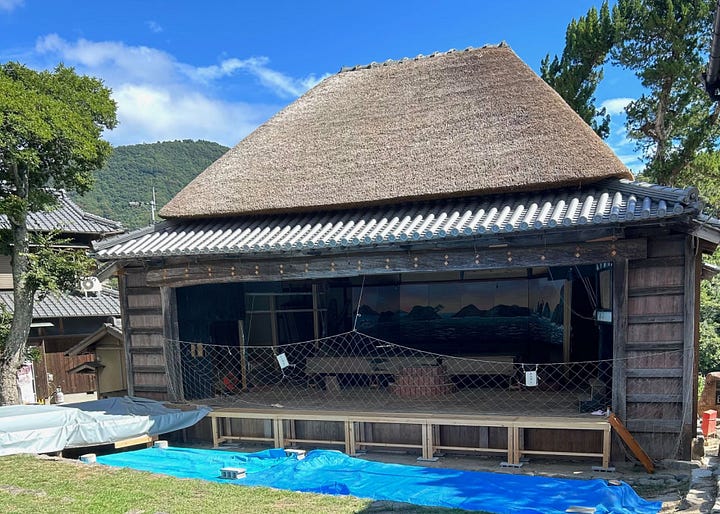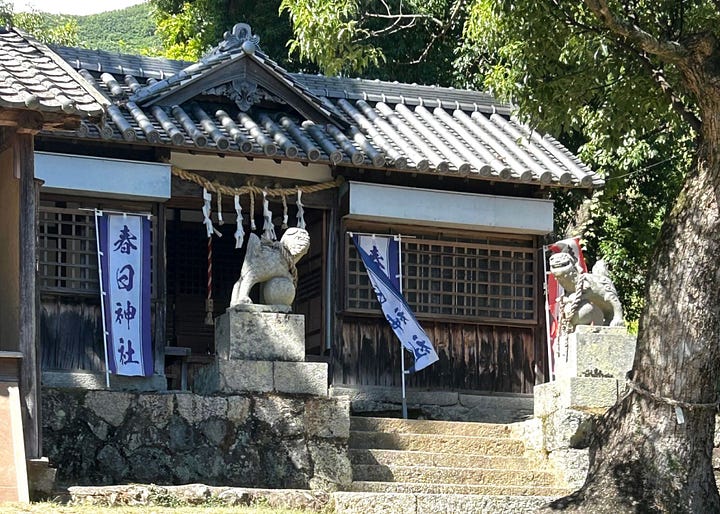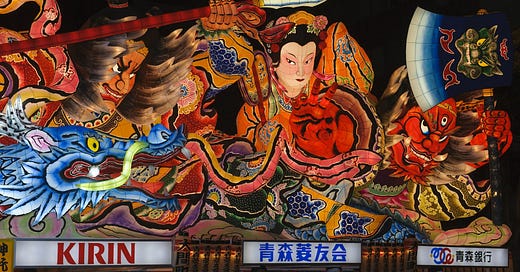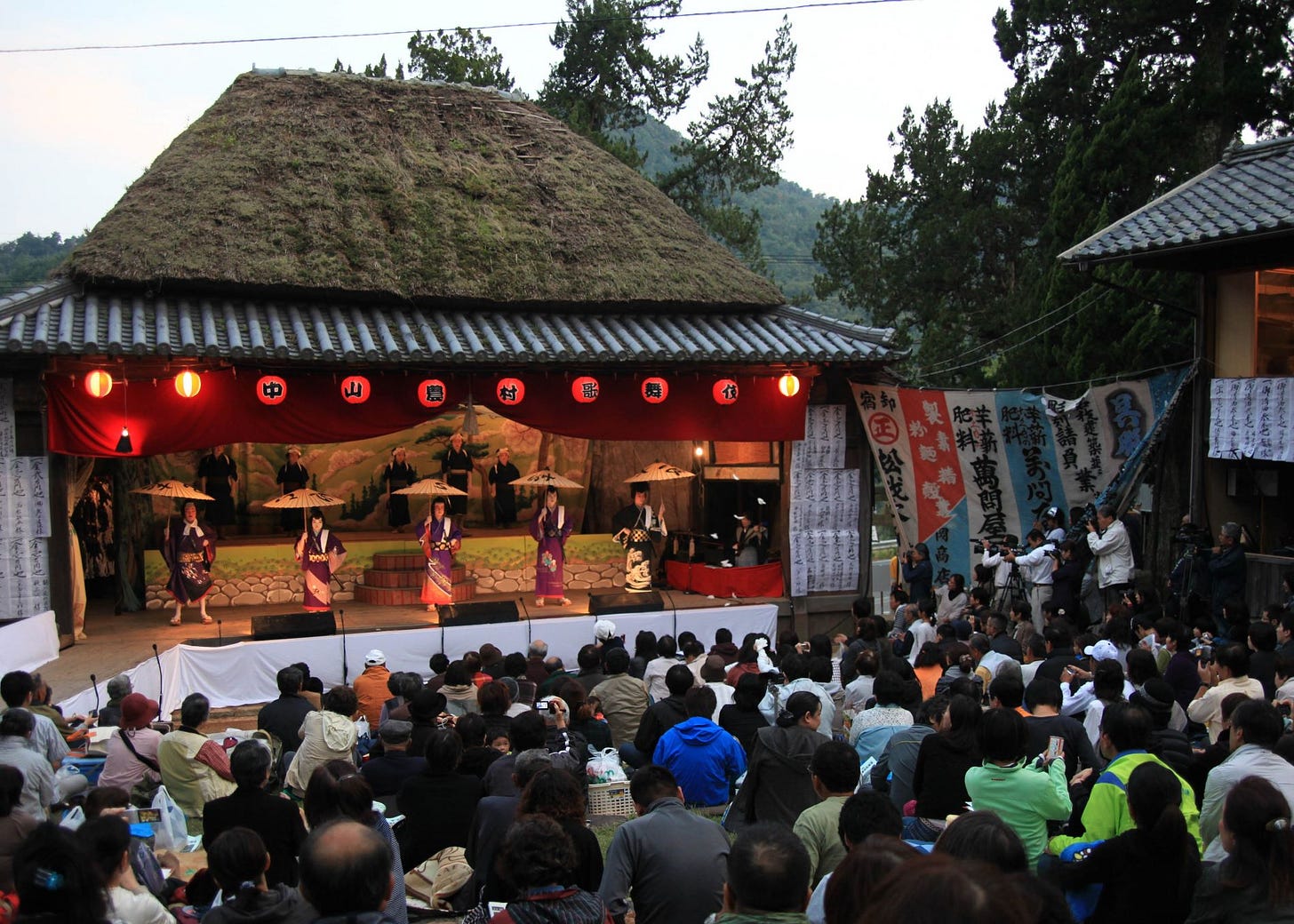There are about 300 thousand festivals (called Matsuri) in Japan. Festivals vary in size, but each has a background and reflects the culture of the area. The Nebuta Festival, famous as one of the five major festivals in Japan, also has a very interesting background and culture.
The Nebuta Matsuri is a summer festival in Aomori, Japan, where giant lanterns measuring 9 meters wide, 5 meters high, and 8 meters deep are paraded around the streets. The town is filled with energy with the sound of festival music called "Nebuta-bayashi," the shouts of "rassera," and the many people enjoying the Nebuta Matsuri. Approximately 3 million people visit during the six-day event.
All of the pictures on the giant lanterns are hand-painted by artists called "Nebutashi." The "shi" in "Nebutashi" has a similar meaning to "master," and refers to a person with advanced techniques and high artistic sensibility.
Nebutashi paints pictures on white lanterns that are made by assembling timber and pasting washi paper on them, but painting pictures on such a huge lantern is no easy task. Before assembling the timber, the nebutashi paints a rough sketch while imagining the finished shape, and shares it with the people who will assemble the timber and paste the washi paper, and it takes several months to complete the Nebuta.
The Aomori search site Pomitto provides an easy to understand explanation in English of the process from Nebuta to completion.
Origin the Nabuta Matsuri
The origins of the Nebuta Matsuri are unclear, but it is thought to be a fusion of the Tanabata Matsuri, which was introduced from China during the Nara period (710-794), and an ancient traditional event in the Tsugaru region (western Aomori Prefecture).
The Tanabata Matsuri is a custom that remains in Japan today, in which bamboo is decorated with strips of paper on which wishes are written, and then released into a river or the sea on July 7th (nowadays it is burned), and during the Heian period (806-1190) it was also imperial court event. However, the Tanabata Matsuri at that time was apparently different from what it is today.
Tanabata Festival in the Heian Period
Originally, Tanabata is a Chinese legend in which the goddess of sewing, "Weaving Star (Orihime)," and the farmer, "Cowherd Star (Hikoboshi)," can meet once a year across the Milky Way.
The Tanabata Matsuri in the Heian period was called "Kikkoten" and was an event celebrating July 7th, the day when Orihime and Hikoboshi meet.Tables were placed on the north and south sides of the garden, and seafood, fruits and vegetables, the seven autumn herbs, five-colored cloth and thread, sake cups, incense burners, lotus and Chinese catalpa leaves were arranged, and incense was burned all night. According to Kimiko Reisei of Kyoto, whose ancestor was a waka poet of the Heian period, there were also performances of kemari and gagaku (court music), and waka poetry gatherings where love poems were composed. Since Orihime was also the goddess of sewing, it seems that prayers were also included for the skill of kemari, gagaku, and waka poetry,
Kikkoten was also held among the common people, but it seems to have been more modest than that held at the imperial court. It is said that the practice of hanging strips of paper with wishes written on them on bamboo, like the modern-day Tanabata Matsuri, began during the Edo period (1615-1868).
Changes in Matsuri
During the Edo period, the long warring states era came to an end, and the development of irrigation technology and the shipping industry brought economic growth. It is said that the population was concentrated in urban areas such as Edo and Osaka due to centralization by the Tokugawa Shogunate.
In Edo, various town cultures flourished, and sumo and kabuki became popular.
Then, in the mid-Edo period, a local form of kabuki called Noson Kabuki began to be performed. The kabuki actors were farmers from the village. Most of these were performed as dedicated to the gods and as entertainment for the villagers during ceremonies held at shrines to give thanks for the harvest. Therefore, the stage for Noson Kabuki was located within the shrine grounds.
It is believed that in this way, rituals and events, which were originally separate, merged and the current style of "Japanese Matsuri" was established.
Japan is said to be a country with many "Matsuri." The "Spring Matsuri" is a prayer for abundant grain harvests, the "Summer Matsuri" is a prayer for the elimination of evil spirits and epidemics and the prevention of wind and flood damage, and the "Autumn Matsuri" is a prayer to give thanks for the harvest. Each of these matsuri is deeply related to agriculture. However, in recent years, these meanings have been forgotten, and it seems that there are more matsuri as entertainment. It is also said that depopulation in rural areas is making it difficult to hold festivals. Noson Kabuki is no longer performed in most villages these days.
Customs forbidden to women
In Shodoshima, where I was born and raised, Noson kabuki is still performed in two villages, and many tourists come to watch it. The actors are not farmers, but are made up of local people. My father also performed on the Noson Kabuki stage several times when he was young (probably about 60 years ago), but he says he was very confused at first. After all, he was born and raised in Kyoto, famous for the Gion Matsuri, so the Matsuri, local culture, and everything else were different. But being a curious guy, he probably enjoyed the differences.


In Shodoshima, children's kabuki and children's sumo were also held as dedication ceremonies. While Noson Kabuki was held on a large village (a collection of small villages) basis, children's kabuki and children's sumo were held on a small village basis, and continued until I was a child. According to records, these also seem to have started in the Edo period. They seemed to have had various meanings, such as dedication to the gods worshiped in each village, entertainment for the villagers, passing on customs, and deepening the bonds between villagers.
However, in children's kabuki, girls are not allowed on stage. Of course, they were not allowed to enter the ring (called Dohyo) in children's sumo either. I remember that we girls just watched. That was also an old Japanese custom.
According to Masataka Suzuki, a folklorist and religion scholar, there are various theories about this custom, such as "blood impurity in Shinto," "Buddhist precepts," and "misogynistic ideas found in Buddhist scriptures," but he says that the original "blood impurity" was influenced by Buddhist ideas and changes in social structure over time, leading to misogyny. Although it may seem like a very old custom, the term "forbidden of women" first appeared in documents during the Muromachi period (1392-1573).
It cannot be denied that for hundreds of years since then, women's participation has been restricted not only in Shinto and Buddhist ceremonies, but in various other situations as well. The same restrictions also existed for Nebuta Matsuri, who were told that "women cannot make Nebuta." However, this assumption was overturned by Asako Kitamura, who came into the limelight in 2012 as the first female “Nebutashi.” Her work can be seen at Expo 2025 Osaka, Kansai, Japan currently being held.
Although Japan still has some misogynistic aspects, things are definitely changing. The Circular Cotton Paper used in her work was also born from the thoughts of one woman. It was my encounter with this woman that inspired me to write this article. Circular Cotton Paper, made from recycled discarded clothing, helped me to realize a reality that I could not ignore, as I grew up in a family that ran a sewing company.
The continuation of this will be in the next article.
Along with nostalgic memories of the time when Japanese sewing techniques were highly regarded around the world.
Reference
渡辺実. (1999). 日本食生活史 (19). 吉川弘文館
鈴木正崇. (2019). 山岳信仰 (3). 中公新書
柳田圀男. (2023). 日本の祭り (25). 角川ソフィア文庫.
星野紘. (2006). 日本の祭り文化辞典. 東京書籍.






